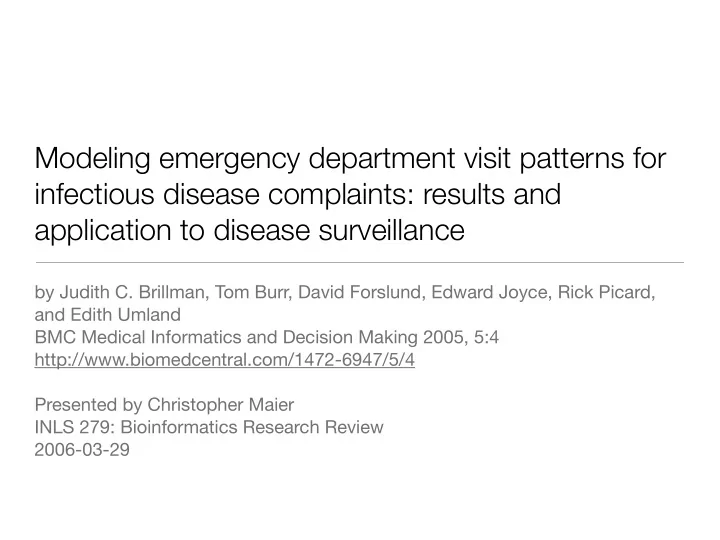

Modeling emergency department visit patterns for infectious disease complaints: results and application to disease surveillance by Judith C. Brillman, Tom Burr, David Forslund, Edward Joyce, Rick Picard, and Edith Umland BMC Medical Informatics and Decision Making 2005, 5:4 http://www.biomedcentral.com/1472-6947/5/4 Presented by Christopher Maier INLS 279: Bioinformatics Research Review 2006-03-29
Public Health Surveillance • “ongoing, systematic collection, analysis, interpretation, and dissemination of data about a health-related event for use in public health action to reduce morbidity and mortality and to improve health” • Supporting Case Detection and Public Health Interventions • Estimating the Impact of Disease or Injury • Portraying the Natural History of a Health Condition • Determining the Distribution and Spread of Illness • Generating Hypotheses and stimulating Research • Evaluating Prevention and Control Measures • And... See http://www.cdc.gov/mmwr/preview/mmwrhtml/ rr5305a1.htm for more
Outbreak Detection • Outbreaks are defined as “increase in frequency of disease above the background occurrence of the disease” • Traditionally detected by examining collected case reports or by clinicians observing clusters of disease incidence and issuing alerts • This can be slow, however • Availability of electronic data provides new possibilities for quicker detection • The threat of bioterrorism provides strong motivation
Syndromic Surveillance • Uses pre-diagnosis health data (i.e. monitor the symptoms for characteristic patterns). Helpful for bioterrorism since the diseases caused by bioterror agents are rare, often misdiagnosed, and overlap in their presentation • If collected electronically, can provide rapid response relative to traditional means (wait for diagnosis, or discharge evaluation) • “Drop-In” systems denote short-term solutions, such as those put in place to detect bioterror threats for DNC, RNC, Olympics, immediate post-9/11 NYC, etc. • Often difficult to maintain long term because they require care providers to collect non-routine information, instead of using pre-existing data • Also, have no baseline knowledge See http://www.cdc.gov/ncidod/EID/vol9no3/02-0363.htm
Using Emergency Department (ED) Data • Main question to be answered: can emergency department data be used in syndromic surveillance to achieve more timely indicators of outbreaks?
Categorization: Defining the Syndromes • Important task for any syndromic surveillance system • Took chief complaints (CCs) from 9 years of records • recorded by triage nurse, entered into system by clerk • Looked at all CCs that occurred over 5 times in the corpus, condensed and grouped them • Groupings reviewed by medical experts
Model • Use “started log” counts • Equation reflects weekly, seasonal periodic patterns in ED data � S ( d ) = [ c i × I i ( d )]+[ c 8 + c 9 × d ]+[ c 10 × cos(2 πd/ 365 . 25)+ c 11 × sin(2 πd/ 365 . 25)] i
Page’s Statistic • Need to compare incoming CC counts to baseline model; if it’s higher, it could signal an outbreak of some disease or condition P ( d ) = maximum of 0 and [ P ( d − 1) + � d /s d − 1 / 2]
Evaluation: Comparison with traditional surveillance • Compared respiratory data to influenza data collected by New Mexico Department of Health for 2002–2003 flu season
.biomedcentral.com/1472-6947/5/4/figure/F2 .biomedcentral.com/1472-6947/5/4/figure/F2
Outbreak Simulation • Add in extra counts to simulate 1-day, 1–10 day, and 2–10 day outbreaks and see if the system can detect them.
Hierarchical Model • Basic model presented treats all seasons equally, which isn’t necessarily true when dealing with various classes of complaints • Hierarchical models replace the sine and cosine functions with other Gaussian functions • Could be used in practice, but is very computationally expensive, requiring frequent updating of the model • First order model seems to work well enough though, so stick with it
Summary • Emergency Department information can be used for timely outbreak detection • Page’s statistic can be used to characterize baseline data • Simple first order model is sufficiently sensitive to changes in CC counts • Performance of the system depends on how CCs are recorded, the categories CCs are grouped into, and the method by which CCs are assigned to categories
Stephen Colbert says: Support your local medical information scientist! Timely By then, outbreak detection is it could be... vitally important to our great nation! We too late. cannot afford to wait, because....
Recommend
More recommend